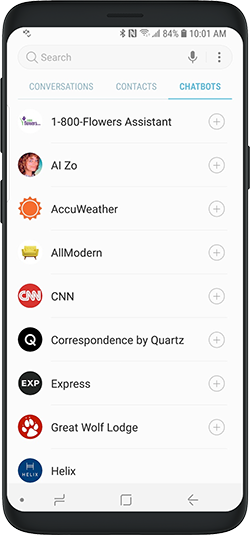RCS Chatbot Directory Opens Up New Opportunities for Marketers
By: Ramy Riad

A New App Store
As RCS continues to make great strides in becoming the global standard for carrier-based messaging and provides a new opportunity for brands to communicate with consumers, a new brand discovery experience has emerged: the chatbot directory.
Launched by AT&T and Samsung to a growing number of capable devices, the chatbot directory gives consumers a new channel. Consumers can now discover brands and launch an RCS-enabled chat through a new directory embedded in the native messaging client. Consumers using RCS-enabled Samsung devices on the AT&T network will now see a third tab at the top of their native text messaging app named Chatbots. Examples of RCS chatbot customer experiences include clipping coupons to loyalty cards, shopping the latest trends, securing tickets for upcoming events and checking the weather—all within the native messaging client, no app to download or update.
As enterprises and brands continue to seek direct, one-on-one customer communication moments, the RCS chatbot directory creates an enormous opportunity for brands to extend their reach and drive acquisition, increase retention and build loyalty without having to rely on the advertising-sponsored, third-party channels such as Facebook Messenger or WhatsApp that intermediate the relationship.
With the launch of the RCS chatbot directory, brands also now have access to new beachfront real estate on the mobile device. Think of the directory as a new app store—a place where consumers can proactively seek out chatbots and engage with their favorite brands on their own terms. But unlike Google Play or the Apple App Store, consumers have no apps to download, keep updated or decide if the app is worth the space on their device. Additionally, brands can provide an app-like experience with RCS chatbots while avoiding the cost of app development and upkeep associated with traditional native apps. And instead of going unused or buried in a folder deep on a consumer’s device, these RCS conversations with brands are kept intimately right alongside conversations with friends and family in the app most used on the device—the native message client.
The Rise of RCS Business Messaging
RCS Business Messaging is on its way to replacing SMS as the go-to messaging channel for direct, brand-to-consumer communications. Launched by 65 operators in 46 countries and with more than 40 operator launches scheduled over the next 12 months, RCS is quickly transforming carrier-based mobile messaging into a rich digital communication platform for enterprise brands and operators across the globe. The mobile ecosystem, including device manufacturers, operating system providers, carriers and vendors, is working together to ensure interoperability support, which is expected to make great strides in 2019.
The power of RCS lies in the features it brings to native mobile messaging. RCS harnesses advanced device capabilities and enhanced UI elements to provide an app-like experience to traditional text messaging. Some key features of RCS business messaging that are supported by the Universal Profile (the GSMA-published, globally agreed-upon standard) include rich cards, carousels, suggested replies and actions, and delivery and read receipts.
Soon brands will begin piloting integrated payments, which will unlock true, seamless conversational commerce. Customers will be able to purchase products and services directly within an RCS engagement, leveraging native payment capabilities such as Google Pay.
How Brands Envision Using RCS
An increasing number of brands are beginning to pilot RCS functionality through communications with customers. But how exactly are brands planning to use RCS? A recent study of marketing personnel in the US from industry data expert Mobilesquared provides insight into how companies plan to use RCS to break out from traditional text messaging and enhance engagements with their customers.
When asked where they could envision their company using RCS, “Marketing and Promotions” ranked highest with 55 percent of responses from the surveyed companies. This figure is consistent with many of the early, in-market RCS pilots. Numerous early adopter brands have begun to use the rich functionality of RCS to communicate sales and promotions with their existing opted-in database. With the use of rich card carousels and suggested actions, RCS enables marketing and promotions to be much more interactive for consumers—making this a logical starting point for brand marketers. However, marketing and promotions wasn’t the only area brands could envision using RCS.



















